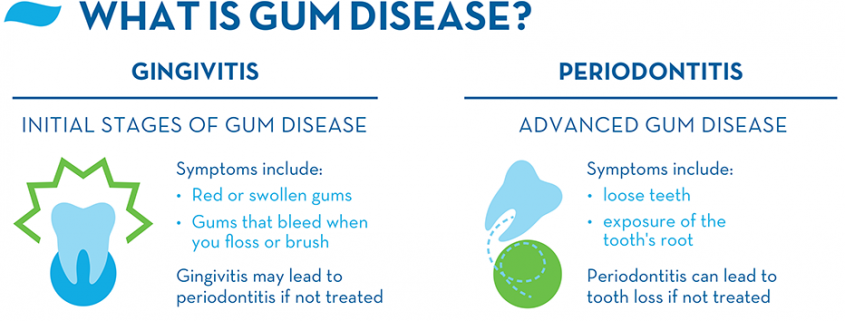What is the Difference Between Periodontitis and Gingivitis?
Everyone has heard of gingivitis – it’s mentioned in practically every commercial for dental products! It’s like the boogeyman of the dental realm, but unlike the boogeyman – gingivitis is very real. Less commonly talked about is periodontitis. The two are related, but what’s the difference between periodontitis and gingivitis?
What is Gingivitis
This is the precursor to periodontitis. Gingivitis is a term that means “gum inflammation” and occurs when enough plaque has built up to allow bacteria to thrive in the mouth. The irritation in the gumline is most noticeable when brushing, as the gums bleed very easily. The good news is, gingivitis is reversible, and no permanent damage has occurred at this stage. Signs of gingivitis include:
- Swollen gums
- Reddened gums (healthy gums are pink)
- Gums that bleed during brushing
- Receding gums
- Tender gums
- Bad breath
- Soft, puffy gums
If you experience any of the symptoms above, it’s important to seek dental care to prevent the disease from developing any further. Typically, a professional cleaning will clear up gingivitis, as long as proper steps are taken at home to reverse the effects of gingivitis. This includes brushing at least twice daily, flossing once a day, and using an antiseptic mouth rinse. However you should be doing those things anyway! If you don’t catch gingivitis in time…
What is Periodontitis
You’ll wind up with periodontitis – gum disease. At this stage, your gums will begin to pull away from your teeth, creating small pockets where food, plaque, and other debris will build up. As these pockets fill, they become breeding grounds for harmful bacteria. And bacteria just loves to destroy healthy tissue. The bone and connective tissue that is normally protected by your gums will start to break down. The longer it goes untreated, the more damage is caused. Periodontitis eventually results in tooth loss – because the bone and connective tissue anchoring the teeth in place gets destroyed. As a matter of fact, gum disease is the number one cause of adult tooth loss.
There are other factors that can contribute to gum disease, including:
- Hormonal changes
- Decreased immunity due to certain illnesses
- Certain medications
- Poor oral hygiene habits
- Smoking
- Old age
- Certain viral or fungal infections
- Substance abuse
- Poor nutrition
- Poorly fitted dental restorations
In the case of either gingivitis or periodontitis, it’s important to visit the dentist immediately in order for proper treatment. Without it, you could lose one or more teeth! If any of these symptoms sound familiar, call Dr. Chauvin’s office to set up an appointment today.



